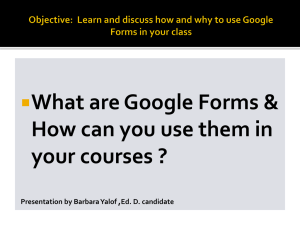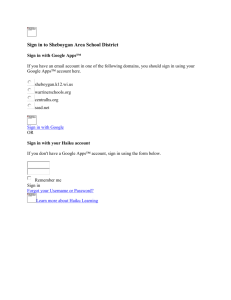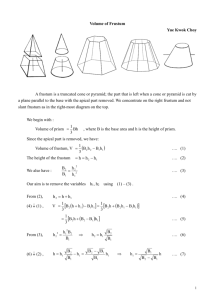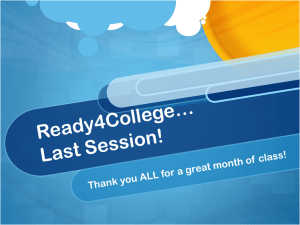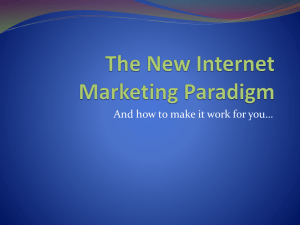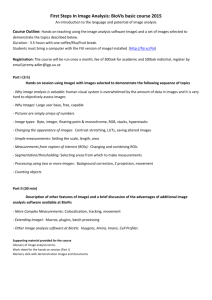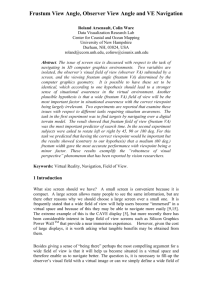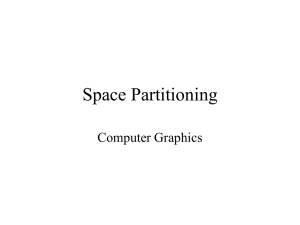Integration Packet - MisterSyracuse.com
advertisement
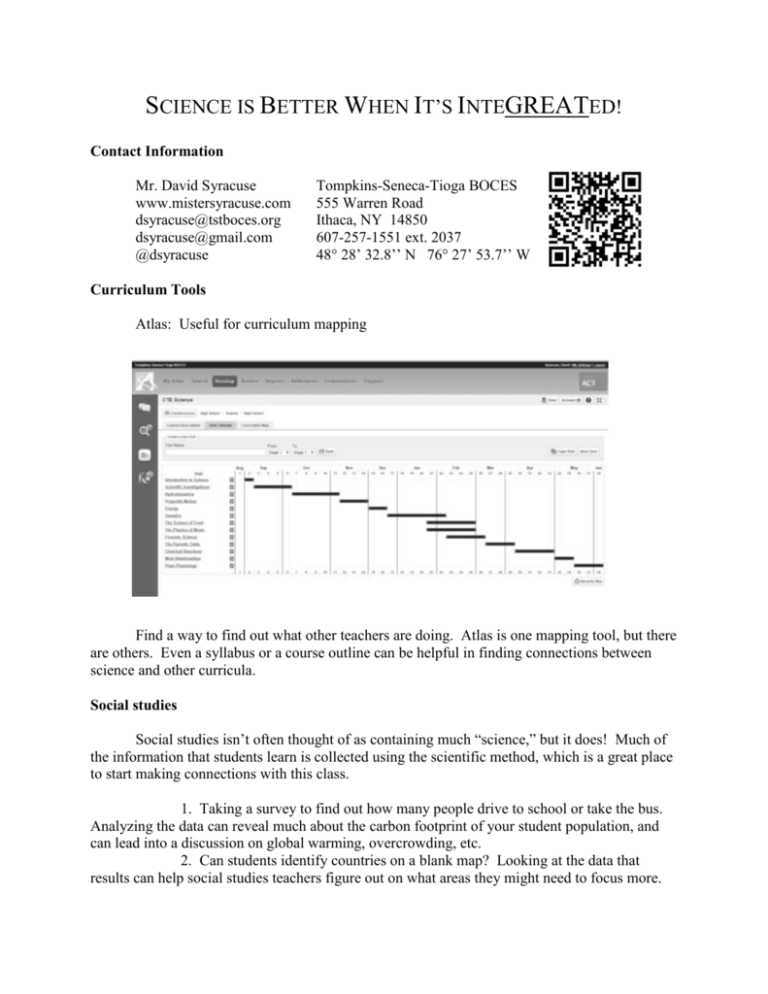
SCIENCE IS BETTER WHEN IT’S INTEGREATED! Contact Information Mr. David Syracuse www.mistersyracuse.com dsyracuse@tstboces.org dsyracuse@gmail.com @dsyracuse Tompkins-Seneca-Tioga BOCES 555 Warren Road Ithaca, NY 14850 607-257-1551 ext. 2037 48° 28’ 32.8’’ N 76° 27’ 53.7’’ W Curriculum Tools Atlas: Useful for curriculum mapping Find a way to find out what other teachers are doing. Atlas is one mapping tool, but there are others. Even a syllabus or a course outline can be helpful in finding connections between science and other curricula. Social studies Social studies isn’t often thought of as containing much “science,” but it does! Much of the information that students learn is collected using the scientific method, which is a great place to start making connections with this class. 1. Taking a survey to find out how many people drive to school or take the bus. Analyzing the data can reveal much about the carbon footprint of your student population, and can lead into a discussion on global warming, overcrowding, etc. 2. Can students identify countries on a blank map? Looking at the data that results can help social studies teachers figure out on what areas they might need to focus more. Plus, the ability to give feedback to teachers (“tell them what to teach”) is always exciting for students. 3. Using GIS software or Excel spreadsheets to analyze weather data is a great way to track droughts and other phenomena. This can help explain why certain civilizations started in certain places. Or why living in a desert and moving water through a pipeline is expensive! Use the link below to find past climate data from the National Oceanic and Atmospheric Administration. You can search by zip code, date, weather type and more. Get Data: http://www.ncdc.noaa.gov/cdo-web/ Fine and Performing Arts The connections here abound! Colors and sounds are all based on science. Aesthetics is frequently related to symmetry. The way that we perceive a given signal all comes down to neuroscience. 1. Use a microphone and Vernier software to view the waveforms of various types of instruments. Or the waveforms produced by an electronic keyboard and a piano. Or an upright and grand piano. Patterns can be found between instruments made of wood vs. metal, and electronic vs. “real.” 2. Explore why some chords sound “good” and why others sound “bad.” Investigate constructive and destructive interference and wavelength by visualizing the waveforms of various chords played on the piano. Using tuning forks, a digital video camera and free software, you can count the vibrations (for lower frequency notes). The software is called ImageJ, and is used for everything from analyzing cell movements to tracking projectiles. Get ImageJ: http://imagej.nih.gov/ij/index.html 3. The colors of paintings are made from chemicals that reflect light in a specific way. Dilute the paints and using a spectrophotometer to measure their absorbance or transmission. Then see if students can match up the paints to pure chemicals (e.g. titanium dioxide for while, carbon for black, cobalt chloride for blue). The following link gives plenty of information on which chemicals are used for which colors. Get paint chemical info: http://www.jcsparks.com/painted/pigment-chem.html Math The key here is really to find something about math that is exciting. Students have all made graphs before, but they rarely use graphs as tools. They’ve all found what x equals, but when that equals something unexpected or exciting, it’s more likely that they’ll engage. 1. The volume of irregularly-shaped objects is often tough to find. For Pi day, consider calculating the volume of a pie tin (a shape known as a frustum) to figure out how much pie filling must be used. Alternately, figuring out the volume of a balloon, then figuring out how many balloons it might take to fill the principals’ office with balloons….then actually doing it, can be very satisfying. Calculating the number of moles of a gas needed to fill the balloons can also be incorporated. The link below from the University of Georgia shows the formula for the volume of a frustum. Get the formula: http://jwilson.coe.uga.edu/emt725/Frustum/Frustum.cone.html 2. Have the students make their own equations. We often use formulae but rarely do we create them. Pythagoras is famous, but why not Jimmy from period three? Ask the students to create a formula that describes the number of students per class or teachers per student. Any input and output will do. 3. Using Vernier software to capture the motion of an object is very easy to do. You can play back the video frame by frame to track the motion, then calculate the speed, acceleration, direction, etc. When students compete to see who can run or throw the fastest, it makes math fun! LoggerPro costs $229, but you only have to buy it once, the support is GREAT (the company is run by a former teacher), and you can install the program on as many computers in your district as you’d like. Students can even install it on computers at home. There is a free version called LoggerLite, but it doesn’t have as many functions, and you can’t analyze video with it. Get LoggerPro: www.vernier.com English, Language Arts and Foreign Languages A little trickier here, but it can be done! All languages are codes, and codes have patterns that can be analyzed. 1. Import sections of a book, poems or other written works into word, then use find feature to count the frequency of certain words. Comparing the different parts of speech in various types of literature (e.g. the ratio of nouns to verbs, etc.) can be illuminating. 2. Technical writing plays an expanded role in the CCLS for ELA. Having students write lab reports, edit them and publish them is a great way to show the full-circle nature of the scientific process. We don’t often have high school students sharing their work with each other. SHAMELESS PLUG: You should really consider having your students submit their lab work to the Finger Lakes Journal of Secondary Science. TST BOCES students edit the work and students get published in an actual, peer-reviewed, registered periodical! Neat. Get to the FLJSS: www.fljss.com 3. Use some of Google’s analytical tools like Trends to see what terms are being Googled and when. Here’s an example for “bathing suit.” Clearly, there is a particular time of year when people are looking to buy swimwear online. Google also keeps track of its “Hot searches,” so you can see the top things that people are typing into Google. Get Trends: http://www.google.com/trends/?hl=en Science Holidays Celebrating science holidays is an easy, school-wide way to engage students in science. Pi day and Mole day are obvious choices, but check out these other ideas: 1. National Metric Week is celebrated by the United States Metric Association, and it happens in the week that contains October 10th (10/10). Plenty of opportunities here to organize a 10K race, sell candies in groups of 10, or other metric-y things. Get metric: www.metric.org 2. There are lots of other holidays, from Darwin Day (Feb. 12th, his birthday), to Newton Day (July 5th, when Principia was published). Find more here: Get nerdy holidays: http://www.geekorizetalk.com/geek-holidays/ Career and Technical Education CTE Programs are just one more way that students can earn a Regents Diploma. There will soon be a “CTE Pathway” to graduation, substituting CTE experience for one of the five required Regents Exams. Technology is Your Friend! If you’re working with another teacher or a class that you don’t see often, keeping in touch is important. Here are some ideas to help out: 1. Remind.com: A service that allows you to safely send text message or e-mail reminders to students. 2. Polleverywhere.com: A way for students to tweet or text answers to you. 3. Popplet.com: A cool way to interactively make idea webs. 4. Slideshare.com: Share your presentations with multiple people and access them online from anywhere. 5. Prezi.com: Better than a PowerPoint…great online presentation tool! 6. Google docs and Google Apps for Education: You can share documents, edit them, have students turn in papers, grade them and hand them back…without printing anything. Your tech administrator needs to set it up, but it’s all free!




